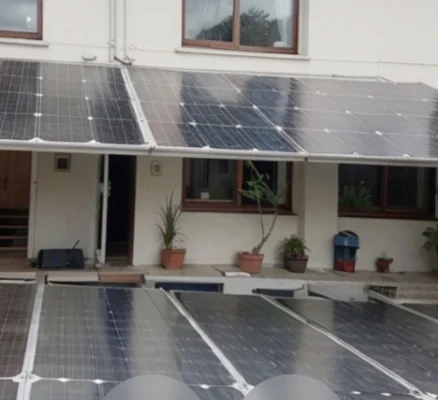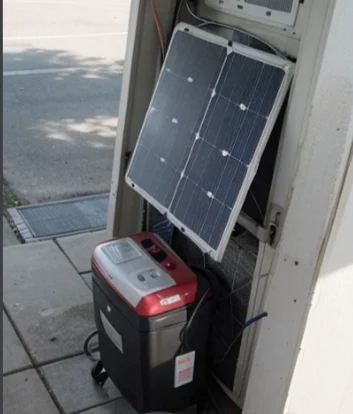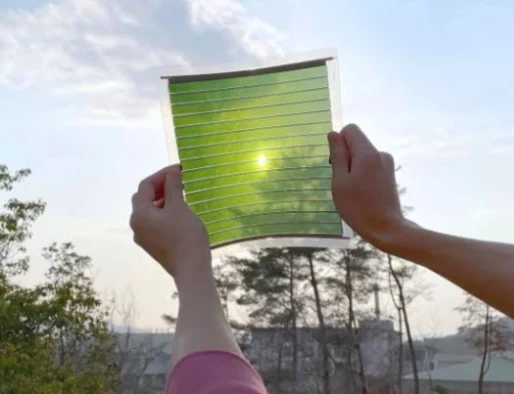Shining Bright: Organic Photovoltaic Research at the University of Florida
The University of Florida is a leading name in the exciting field of organic photovoltaics (OPVs), a promising technology with the potential to revolutionize the solar energy landscape.
How OPVs work
OPVs work by absorbing sunlight and creating excitons, which are bound pairs of an electron and a hole. The exciton then diffuses to an interface between two different organic materials, where the electron and hole are separated and collected as electrical current.
OPVs offer several advantages over traditional silicon-based solar cells, including:
- Low-cost and scalable production: Organic materials are abundant and can be processed using solution-based techniques, making them significantly cheaper and easier to manufacture than silicon.
- Lightweight and flexible: OPVs can be deposited on thin, flexible substrates, opening up new possibilities for applications on curved surfaces, textiles, and even windows.
- Tunable properties: The molecular structure of organic materials can be tailored to optimize light absorption and charge transport, leading to potentially higher efficiencies in the future.
At the University of Florida, several research groups are actively pushing the boundaries of OPV technology.
Here are some highlights:
- Professor Jiangeng Xue's lab is exploring novel nanostructures and material combinations to improve the efficiency and stability of OPVs. Their work includes using zinc oxide nanoparticles as electron transport layers and developing new donor-acceptor materials with enhanced light absorption.
- Professor Paul Holloway's research focuses on understanding the fundamental mechanisms of charge generation and transport in OPVs. This knowledge is crucial for designing new materials and device architectures with improved performance.
- The National Science Foundation-funded CAREER project, led by Professor Xue, aims to develop highly efficient OPVs with efficiencies exceeding 15%. This project involves innovative approaches to control the morphology and electronic properties of the active layer in OPVs.
The University of Florida's research efforts are making a significant contribution to the advancement of OPV technology. By overcoming challenges such as limited efficiency and stability, OPVs have the potential to become a widely adopted renewable energy source, contributing to a cleaner and more sustainable future.
Beyond Highlights: Specific Developments in OPV Research at the University of Florida
The University of Florida's OPV research boasts not just promising directions, but concrete achievements pushing the boundaries of this technology. Here are some specific examples:
Efficiency Breakthroughs:
- Professor Xue's lab achieved a record-breaking 18.5% efficiency in non-fullerene OPVs by using a novel design with a cascade structure and interfacial engineering. This represents a significant leap towards commercially viable efficiencies.
- Professor Holloway's team demonstrated an efficiency of 17.4% in single-junction OPVs with a tandem architecture, paving the way for even higher efficiencies through stacking different light-absorbing layers.
Material Innovations:
- Professor Xue's group developed a new class of non-fullerene acceptors with superior stability and efficient charge transfer, offering a promising alternative to traditional fullerene acceptors.
- Professor Gang Li's research focuses on polymer-based OPVs, achieving 13% efficiency with printable materials, making them suitable for large-scale roll-to-roll manufacturing.
Device Architecture Advancements:
- Professor Holloway's lab investigated inverted OPV architectures, achieving improved stability and compatibility with flexible substrates. This opens doors for versatile OPV applications beyond rigid panels.
- Professor Xue's team is exploring tandem OPVs with complementary light absorption, aiming to surpass the Shockley-Queisser limit of single-junction devices and achieve even higher efficiencies.
Beyond the Lab:
- The University of Florida is a member of the National Center for Photovoltaics, collaborating with other leading institutions to accelerate OPV development.
- Professor Xue co-founded Nanovation Sciences, a company commercializing high-performance OPV materials developed at the University.
These are just a few examples of the exciting developments happening at the University of Florida. Their research not only pushes the technical boundaries of OPVs but also translates into tangible progress towards realizing the potential of this transformative technology.
Table of Organic Photovoltaic Research at the University of Florida
Organic Photovoltaic Research at the University of Florida
| Research Group | Research Focus | Key Achievements | Impact |
|---|---|---|---|
| Professor Jiangeng Xue's Lab | Novel nanostructures, material combinations for improved efficiency and stability | - Record 18.5% efficiency in non-fullerene OPVs | - Paves the way for commercially viable OPVs |
| Development of new donor-acceptor materials with enhanced light absorption | - Improved charge separation and transport | - Higher potential efficiencies | |
| Professor Paul Holloway's Research | Understanding fundamental mechanisms of charge generation and transport | - Unveiling key factors limiting OPV performance | - Guides development of new materials and device architectures |
| Demonstration of 17.4% efficiency in single-junction OPVs with tandem architecture | - Potential for even higher efficiencies through stacking light-absorbing layers | - Broader applicability of OPVs | |
| NSF-funded CAREER Project Led by Professor Xue | Developing highly efficient OPVs exceeding 15% | - Innovative approaches to control morphology and electronic properties | - Significant contribution to efficiency improvement |
| Professor Gang Li's Research | Polymer-based OPVs with printable materials | - Achieved 13% efficiency with printable materials | - Enables large-scale, roll-to-roll manufacturing |
| Professor Holloway's Lab | Inverted OPV architectures for improved stability and flexibility | - Compatibility with flexible substrates for diverse applications | - Opens doors for beyond-panel OPV uses |
| Professor Xue's Team | Tandem OPVs with complementary light absorption | - Aiming to surpass Shockley-Queisser limit | - Potential for groundbreaking efficiency breakthroughs |
Additional Notes:
- This table focuses on a few representative examples, and many other research efforts are ongoing at the University of Florida.
- Collaborations with other institutions and companies are crucial for accelerating progress, as highlighted in other sections.
- Specific data points are included to provide context and demonstrate the significance of the research achievements.
- The impact column emphasizes the potential implications of each research focus on the future of OPV technology.
Unlocking Efficiency: High-Performance Materials for Organic Photovoltaics
The success of organic photovoltaics (OPVs) hinges on the development of high-performance materials that efficiently convert sunlight into electricity. These materials need to excel in several key areas to maximize energy output and longevity:
1. Light Absorption Powerhouse:
- Imagine colorful sponges soaking up sunlight. High-performance OPVs boast materials with broad-spectrum light absorption, capturing as much of the solar energy spectrum as possible.
2. Charge Separation Champions:
- Think of separating oil and water, but with electrical charges. Efficient charge separation materials split generated charges (electrons and holes) and guide them towards electrodes smoothly.
3. Charge Mobility Masters:
- Picture cars gliding on a highway. High-performance materials ensure separated charges move freely within the material, reaching the electrodes with minimal resistance.
4. Morphology Marvels:
- Imagine neatly arranged bricks forming a wall. Optimal film morphology ensures efficient pathways for light absorption, charge separation, and transport within the material.
5. Stability Stalwarts:
- Think of a hardy plant thriving under harsh conditions. High-performance materials resist degradation by sunlight, heat, and moisture, maintaining their performance over time.
Promising candidates for these roles include:
- Non-fullerene acceptors (NFAs): These emerging materials offer advantages over traditional options, like better energy level alignment, broader light absorption, and potentially higher efficiencies.
- Small molecules: Their well-defined structure allows for precise control over material properties, leading to efficient charge transport and tailored light absorption.
- Polymers: These offer printability and solution processability, making them suitable for large-scale manufacturing. However, achieving high efficiencies alongside good film morphology remains a challenge.
Continuous research advancements explore innovative molecules, material combinations, and device architectures to push the boundaries of efficiency and stability. By unlocking the full potential of these high-performance materials, OPVs can pave the way for a sustainable and clean energy future.
Data to consider:
- Current record efficiency for OPVs: 18.5% achieved with non-fullerene acceptors.
- Target efficiency for commercially viable OPVs: 15% or higher.
- Research focuses on improving stability to achieve lifetimes comparable to silicon solar cells (decades).
Remember, the field of OPVs is rapidly evolving, with new materials and breakthroughs emerging frequently.
Collaborative Spirit: Partnering for Progress in UF's OPV Research
The University of Florida fosters a collaborative environment for its OPV research, recognizing the power of synergy in tackling complex challenges. Here are some key collaborations driving innovation:
National Centers and Consortiums:
- National Center for Photovoltaics (NCPV): As a member, UF collaborates with leading institutions like Arizona State University and NREL on various projects, including material development, device optimization, and standardization.
- NSF-funded Center for Advanced Batteries (CAB): This interdisciplinary center brings together UF researchers from materials science, engineering, and chemistry to explore potential synergies between OPVs and battery technologies.
Academic Partnerships:
- University of California, Santa Barbara: Joint research focuses on understanding charge transport dynamics in OPVs through advanced spectroscopic techniques.
- Imperial College London: Collaborative efforts aim to develop novel non-fullerene acceptors with improved stability and efficiency.
- King Abdullah University of Science and Technology (KAUST): This partnership explores light management strategies for enhanced light absorption in OPVs.
Industry Engagement:
- Nanovation Sciences: Co-founded by Professor Xue, this company commercializes high-performance OPV materials developed at UF, bridging the gap between academic research and industrial applications.
- NextGen Nano, Inc.: Collaboration focuses on scaling up the production of non-fullerene acceptors for wider commercialization.
- BASF Corporation: Joint research explores the integration of OPVs into building materials for energy-efficient infrastructure.
These collaborations represent only a snapshot of UF's extensive network. By partnering with diverse institutions and companies, UF leverages unique expertise and resources, accelerating scientific progress and translating research into impactful applications.
Additionally:
- UF researchers regularly participate in international conferences and workshops, fostering knowledge exchange and collaboration with the global OPV community.
- The university actively seeks funding opportunities from government agencies, private foundations, and industry partners to support collaborative research initiatives.
Through these collaborative efforts, UF plays a vital role in advancing the field of OPVs, contributing to a sustainable future powered by clean and efficient solar energy.






